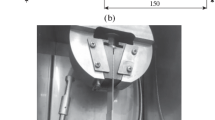Abstract
The theoretical analyses of the stress distribution in bonded joints are of little help to the practical designer. An approximate solution yields an expression for the “average” ultimate shear stress in terms of two constants. This paper shows how these constants can easily be determined experimentally and gives test results which show their temperature dependence and their variation under fatigue-loading conditions. The constants are essential characteristics of a given adhesive and can be used to design any glued joint using this adhesive.
Similar content being viewed by others
Abbreviations
- σ:
-
tension stress in adherend
- τ:
-
shear stress in adhesive layer
- τ avg :
-
average shear stress, defined as load divided by glued area
- τ ult :
-
average ultimate shear stress, defined as ultimate load divided by glued area
- τ o :
-
shear strength, equal to average ultimate shear stress when length of overlap is zero (as a limit)
- P :
-
total axial load in one of the cover plates
- P 1 :
-
axial load at some point in the cover plate within the joint lengthl, as a function ofx
- l :
-
length of overlap
- x :
-
distance from the edge of the plate being joined (main plate)
- t 1 :
-
thickness of one of the cover plates
- 2t 2 :
-
thickness of the main plate
- E :
-
elastic modulus of the adherend
- c :
-
spring constant of the adhesive layer, theoreticallyc=G/d
- G :
-
shear modulus of adhesive
- d :
-
thickness of adhesive layer
- N :
-
number of cycles
References
Beson, N. K., “The Mechanics of Adhesive Bonding,”Appl. Mech. Rvws.,14 (2),83–87 (1961).
Arnovlevic, J., “Das Verteilungsgesetz der Haftspannung bei axial beanspruchten Verbundstäben,”Zeitschrift für Architectur-und Ingenieurwesen,55,414 (1909).
Fillunger, F., “Über die Festigkeit von Löt-, Leim- und Nietverbindungen.”Oesterreichische Wochenschrift für den öffenflichen Baudienst,25 (7–8) (1919).
Volkersen, O., “Die Nietkraftverteilung in Zugbeanspruchten Nietverbindungen mit Konstanten Laschen-querschnitten,”Luftfahrtforschung,15,41–47 (1938).
Volkersen, O., “Schubkraftverteilung im Leim-, Niet- und Bolzenverbindungen,”Energie und Technik, (3),68–71 (5), 106–108 (1953).
Goland, M., andReissner, E., “The Stresses in Cemented Joints,”Jnl. Appl. Mech.,11 (1),A17-A27 (1944).
De Bruyne, N. E., andHouwink, R., “Adhesion and Adhesives,”Elsevier Press, Houston (1951).
Epstein, G., Adhesive Bonding of Metals, Reinhold Publishing Corp., New York (1954).
Hertel, H., Leichtbau, Springer Verlag, Berlin, 410–468 (1960).
Szépe, F., and Platthy, P., Berechnung der Tragfähigkeit von Klebverbindungen. International Association for Bridge and Structural Engineering. 7th Congr., Rio di Janeiro, 1964. Preliminary publication, 489–495.
Szépe, F., Acélszerkezetek, Fémragasztás (Steel Structures. Adhesive Bonding of Metals), Tankönyvkiadó (Textbook Publishing House),Budapest (1964).
Arbeitsblätter für das Metallkleben. Aluminum Verlag Gmbh. Düsseldorf.
Wang, D. Y., “Influence of Stress Distribution on Fatigue Strength of Adhesive-bonded Joints,”Experimental Mechanics,4 (6),173–181 (1964).
Author information
Authors and Affiliations
Rights and permissions
About this article
Cite this article
Szépe, F. Strength of adhesive-bonded lap joints with respect to change of temperature and fatigue. Experimental Mechanics 6, 280–286 (1966). https://doi.org/10.1007/BF02327312
Issue Date:
DOI: https://doi.org/10.1007/BF02327312



